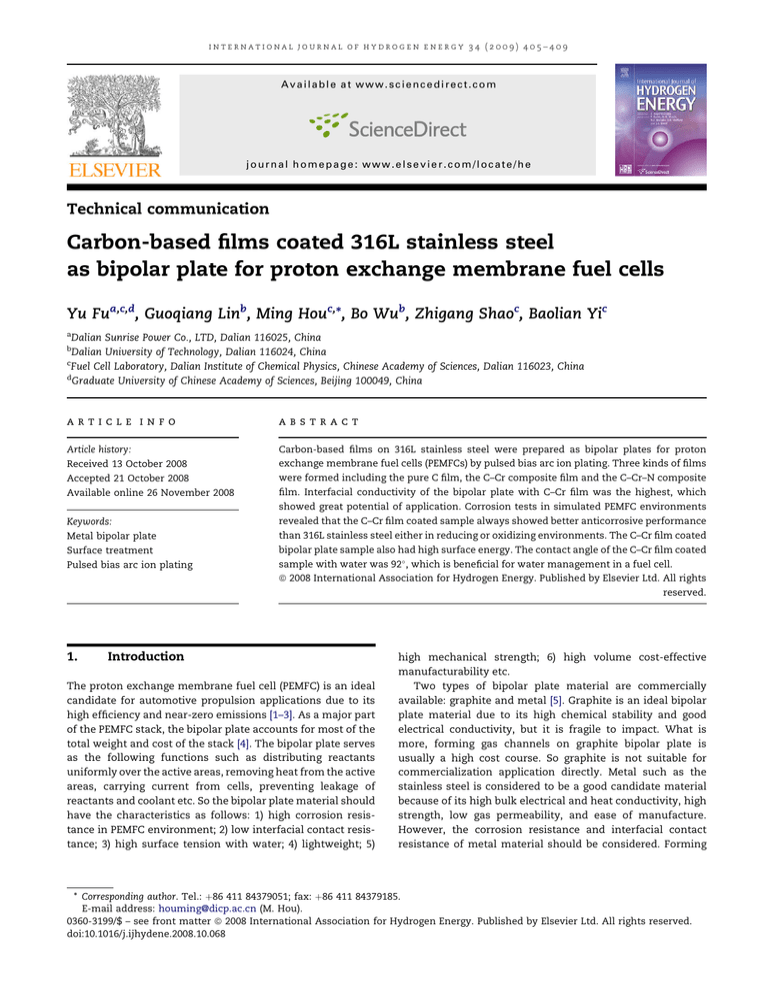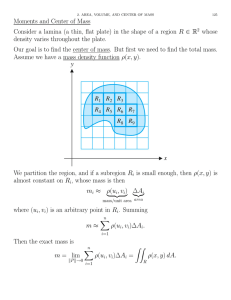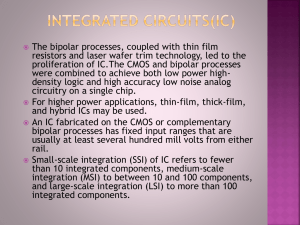
international journal of hydrogen energy 34 (2009) 405–409
Available at www.sciencedirect.com
journal homepage: www.elsevier.com/locate/he
Technical communication
Carbon-based films coated 316L stainless steel
as bipolar plate for proton exchange membrane fuel cells
Yu Fua,c,d, Guoqiang Linb, Ming Houc,*, Bo Wub, Zhigang Shaoc, Baolian Yic
a
Dalian Sunrise Power Co., LTD, Dalian 116025, China
Dalian University of Technology, Dalian 116024, China
c
Fuel Cell Laboratory, Dalian Institute of Chemical Physics, Chinese Academy of Sciences, Dalian 116023, China
d
Graduate University of Chinese Academy of Sciences, Beijing 100049, China
b
article info
abstract
Article history:
Carbon-based films on 316L stainless steel were prepared as bipolar plates for proton
Received 13 October 2008
exchange membrane fuel cells (PEMFCs) by pulsed bias arc ion plating. Three kinds of films
Accepted 21 October 2008
were formed including the pure C film, the C–Cr composite film and the C–Cr–N composite
Available online 26 November 2008
film. Interfacial conductivity of the bipolar plate with C–Cr film was the highest, which
showed great potential of application. Corrosion tests in simulated PEMFC environments
Keywords:
revealed that the C–Cr film coated sample always showed better anticorrosive performance
Metal bipolar plate
than 316L stainless steel either in reducing or oxidizing environments. The C–Cr film coated
Surface treatment
bipolar plate sample also had high surface energy. The contact angle of the C–Cr film coated
Pulsed bias arc ion plating
sample with water was 92 , which is beneficial for water management in a fuel cell.
ª 2008 International Association for Hydrogen Energy. Published by Elsevier Ltd. All rights
reserved.
1.
Introduction
The proton exchange membrane fuel cell (PEMFC) is an ideal
candidate for automotive propulsion applications due to its
high efficiency and near-zero emissions [1–3]. As a major part
of the PEMFC stack, the bipolar plate accounts for most of the
total weight and cost of the stack [4]. The bipolar plate serves
as the following functions such as distributing reactants
uniformly over the active areas, removing heat from the active
areas, carrying current from cells, preventing leakage of
reactants and coolant etc. So the bipolar plate material should
have the characteristics as follows: 1) high corrosion resistance in PEMFC environment; 2) low interfacial contact resistance; 3) high surface tension with water; 4) lightweight; 5)
high mechanical strength; 6) high volume cost-effective
manufacturability etc.
Two types of bipolar plate material are commercially
available: graphite and metal [5]. Graphite is an ideal bipolar
plate material due to its high chemical stability and good
electrical conductivity, but it is fragile to impact. What is
more, forming gas channels on graphite bipolar plate is
usually a high cost course. So graphite is not suitable for
commercialization application directly. Metal such as the
stainless steel is considered to be a good candidate material
because of its high bulk electrical and heat conductivity, high
strength, low gas permeability, and ease of manufacture.
However, the corrosion resistance and interfacial contact
resistance of metal material should be considered. Forming
* Corresponding author. Tel.: þ86 411 84379051; fax: þ86 411 84379185.
E-mail address: houming@dicp.ac.cn (M. Hou).
0360-3199/$ – see front matter ª 2008 International Association for Hydrogen Energy. Published by Elsevier Ltd. All rights reserved.
doi:10.1016/j.ijhydene.2008.10.068
406
international journal of hydrogen energy 34 (2009) 405–409
Fig. 1 – Diagram of the PBAIP experimental setup.
a protecting film with good corrosion resistance and high
interfacial conductivity on stainless steel through surface
treatment is one of the possible solutions [6–10].
Some researches have been conducted on forming carbon
material film on metal bipolar plate. This kind of bipolar plate
could combine the advantages of the two materials. Show
et al. [11,12] coated amorphous carbon film on Ti bipolar plate
at various growth temperatures. They found that the bipolar
plate showed a low contact resistance when the growth
temperature increased up to 600 C, and the fuel cell assembled with this kind of bipolar plate showed an output power of
1.4 times higher than that assembled with the bare Ti bipolar
plates. Fukutsuka et al. [13] prepared carbon coating on
SUS304 using plasma-assisted chemical vapor deposition. The
corrosion resistance of the bipolar plates was improved in
simulated PEMFC conditions, and the interfacial contact
resistance was also greatly reduced. Similar study was also
conducted by Chung et al. [14]. In addition, some patents are
also associated with the technology of metal base/carbon
coating bipolar plates [15–17].
In our study 316L stainless steel substrates were coated
with carbon-based films by pulsed bias arc ion plating (PBAIP)
to obtain protecting layers. PBAIP inherits the advantages of
arc ion plating and brings in new features such as reduced
droplets, dense films and low-temperature deposition. As
a result, films with excellent performance can most likely be
obtained. What is more, forming film by PBAIP is an environment-friendly process. Compared with the Cr–nitride films
formed by PBAIP in our previous work [10], deposition of the
carbon-based film can be greatly accelerated, which is
appropriate for commercial production. This is because that
the carbon source can be induced by the carbon target and not
from the atmosphere. In addition, the economical price of the
carbon target is helpful to lower the bipolar plate cost.
2.
Experimental
The PBAIP system used in this study is shown in Fig. 1. The
316L
stainless
steel
substrates
with
size
of
100 mm 100 mm 0.1 mm were ultrasonically cleaned in
acetone, ethyl ethanol and deionized water for 15 min. Then
they were blown dry and put on holders. The chamber was
evacuated to a base pressure below 5.0 103 Pa using a turbo
molecular pump and a rotary pump. Prior to the deposition,
the substrates were sputtered by Ar ions to remove the
passive film on the stainless steel surface. Then the carbonbased films were deposited with the two targets work
synchronously. Three kinds of films were formed in our study
(Table 1). When forming the pure carbon film, two carbon
targets were used in a vacuum. As for the carbon-based films,
a chromium target and a carbon target were used; the deposition processes were in a high vacuum and in a N2 atmosphere, respectively.
In our setup (Fig. 2) for measuring the contact resistance,
two pieces of Toray carbon paper were sandwiched between
the bipolar plate sample and two copper plates which are
plated with gold on both sides to enhance conductivity. An
electrical current of 5.0 A, sourced by a PSP-2010 Programmable power supply, was provided through the copper plates.
During the tests, the compacting force was increased with
5 N s1 controlled by a WDW Electromechanical Universal
Testing Machine. All the samples (including the bipolar plate
samples and the carbon papers) were wafers with diameter of
60 mm which is the same size as the copper plates.
X-ray photoelectron spectrometer (XPS) was used to characterize the coating.
The corrosion behaviors of the bipolar plate samples were
investigated in simulated PEMFC environments (0.5 M
H2SO4 þ 5 ppm F) by electrochemical tests. The experiments
were performed at 25 C to simulate the environment when
the stack power was off and at 70 C to simulate the environment when the stack power was on. The corrosion solution was bubbled thoroughly with either hydrogen gas (for
Table 1 – Technologies of forming the carbon-based films
with PBAIP.
Film type
C
C–Cr
C–Cr–N
Target
material
Flow rate
of N2 (sccm)
Carbon
Carbon and Cr
Carbon and Cr
0
0
20
407
international journal of hydrogen energy 34 (2009) 405–409
Table 2 – Composition of the composite coating by PABIP
on 316L stainless steel.
Element
C
Cr
O
Fig. 2 – Diagram of the setup for measuring the interfacial
contact resistance.
simulating a PEMFC anodic environment) or pressured air (for
simulating a PEMFC cathodic environment) prior to and
during the electrochemical measurements. The samples were
stabilized at open circuit potential for 30 min, then the
potential was swept at a scanning rate of 2 mV s1.
At last, contact angle of the bipolar plate sample with water
was measured by a JC2000A Contact Angle Measurement to
investigate the surface energy. The contact angle of untreated
316L stainless steel plate with water was also measured for
comparison.
3.
Results and discussion
3.1.
Interfacial contact resistance
Content (At, %)
68.2
17.1
14.7
satisfied, high performance would not be obtained. For this
reason, interfacial contact resistances of the bipolar plate
samples with bare Toray carbon paper were used to screen the
deposition technology. The interfacial contact resistances of
the bipolar plate samples with Toray carbon paper are shown
in Fig. 3. Among all the samples interfacial contact resistance
of the pure C film was 330–2160 mU cm2 under 0.2–1.5 MPa,
which was the highest. The C–Cr–N film showed a better
interfacial conductivity and the interfacial contact resistance
was 107–555 mU cm2 under 0.2–1.5 MPa. But the bipolar plate
with C–Cr–N film could not satisfy the fuel cell application,
too. As for the C–Cr film, it exhibited the best conductivity,
which was far lower than the other two. And the interfacial
contact resistance of the C–Cr film was only 6.86–8.72 mU cm2
under 0.2–1.5 MPa. So the 316L stainless steel plate with C–Cr
film was chosen as candidate of bipolar plate for PEMFC.
3.2.
Characterization of the coating
The XPS analysis result of the bipolar plate with C–Cr film is
shown in Table 2. Over 68% C atom was found in the coating,
and the proportion of Cr and O is 17.1% and 14.7%, respectively.
Obviously, the coating is mainly composed of carbon. As the
coating process was conducted under high vacuum, the
oxygen was very probably induced by surface adsorption when
the sample was exposed to the atmospheric environment.
3.3.
Corrosion resistance
Among all the requirements for the surface-treated metal
bipolar plates, the interfacial conductivity is the most important one. If the conductivity of bipolar plate material is not
Potentiodynamic and potentiostatic tests were used to characterize corrosion resistance of the bipolar plate with C–Cr
Fig. 3 – Contact resistance between the bipolar plate
samples with carbon-based films formed by BPAIP with
Toray carbon paper.
Fig. 4 – Potentiodynamic curves of bipolar plate samples in
0.5 M H2SO4 D 5 ppm FL with a scan rate of 2 mV sL1 at
25 8C.
408
international journal of hydrogen energy 34 (2009) 405–409
Fig. 7 – Contact angle of the coated bipolar plate with water.
Fig. 5 – Potentiodynamic behaviors of bipolar plate samples
in 0.5 M H2SO4 D 5 ppm FL with a scan rate of 2 mV sL1 at
70 8C bubbled with air.
a better corrosion resistance than the base metal in all simulated PEMFC environments.
film. Potentiodynamic polarization curves of the bipolar plate
sample and untreated 316L stainless steel in 0.5 M
H2SO4 þ 5 ppm F solution at 25 C (for simulate the environment when the stack power was off) are shown in Fig. 4. The
coated bipolar plate sample was in passive state under test
condition from 0.1 V to 0.8 V versus SCE. And the untreated
316L stainless steel could be passivated spontaneously under
the same condition from 0.2 V to 0.8 V versus SCE. The
corrosion current densities of bipolar plate sample and 316L
stainless steel were about 107 A cm2 and 105 A cm2,
respectively. The coated bipolar plate sample exhibited much
better corrosion resistance, in accordance with the result of
the corrosion potential experiment. As for the experiments in
0.5 M H2SO4 þ 5 ppm F solution at 70 C (for simulate the
environment when the stack power was on) bubbled with air
(Fig. 5) or H2 (Fig. 6), the corrosion currents were higher than
that performed at 25 C. But the bipolar plate sample exhibited
Fig. 6 – Potentiodynamic behaviors of bipolar plate samples
in 0.5 M H2SO4 D 5 ppm FL with a scan rate of 2 mV sL1 at
70 8C bubbled with H2.
3.4.
Contact angle
The contact angles of the bipolar plate with C–Cr film and 316L
stainless steel with water are shown in Figs. 7 and 8, respectively. Obviously, the bipolar plate sample coated with C–Cr
film has a bigger contact angle (91 ) than 316L stainless steel
(73 ). As we know, the process in fuel cell is always accompanied with water. To prevent the proton exchange
membrane from dehydration, the inlet gases need to be
humidified. In addition, there exists water generated due to
oxygen reduction reaction in the fuel cell stack, so the bipolar
plates are often contacted with the mixture of reactant gas
and water. If the liquid water could not be removed in time,
the water would block the reactant gases accessing to the
electrode. The accumulated water induces the electrode
flooding phenomenon. Furthermore, the water adhering on
the surface of bipolar plate accelerates the corrosion of metal
bipolar plate. For these reasons, this kind of bipolar plate with
Fig. 8 – Contact angle of the untreated 316L stainless steel
plate with water.
international journal of hydrogen energy 34 (2009) 405–409
high surface energy would be helpful for water removal in the
stack and beneficial to the water management.
4.
Conclusion
Carbon-based films on 316L stainless steel substrates were
prepared by PBAIP as bipolar plate material for PEMFCs.
Interfacial conductivity of the bipolar plates with pure C film
or with C–Cr–N film is not satisfied, but the bipolar plate with
C–Cr film showed very low interfacial contact resistance.
Potentiodynamic and potentiostatic tests conducted in
simulated PEMFC environments also revealed that the corrosion resistance of bipolar plate sample with C–Cr film was
greatly enhanced compared with the substrate. What is more,
the contact angle of the sample with water was higher, which
is beneficial for water management in fuel cell. It is concluded
that the 316L stainless steel substrate with C–Cr film might be
a good candidate for bipolar plate for PEMFC.
Acknowledgments
This work was financially supported by the National High
Technology Research and Development Program of China (863
Program, No. 2007AA03Z221).
references
[1] Yi BL. Fuel cell-theory$technology$application. Beijing; 2003.
p. 160–1.
[2] Chalk SG, Patil PG, Venkateswaran SR. The new generation of
vehicles: market opportunities for fuel cells. J Power Sources
1996;61(1-2):7–13.
[3] Hodgson DR, May B, Adcock PL, Davies DP. New lightweight
bipolar plate system for polymer electrolyte membrane fuel
cells. J Power Sources 2001;96(1):233–5.
[4] Tsuchiya H, Kobayashi O. Mass production cost of PEM fuel
cell by learning curve. Int J Hydrogen Energy 2004;
29(10):985–90.
409
[5] Mehta V, Cooper JS. Review and analysis of PEM fuel cell
design and manufacturing. J Power Sources 2003;
114(1):32–53.
[6] Cho EA, Jeon US, Hong SA, Oh IH, Kang SG. Performance of
a 1 kW-class PEMFC stack using TiN-coated 316 stainless
steel bipolar plates. J Power Sources 2005;142(1–2):177–83.
[7] Brady MP, Weisbrod K, Paulauskas I, Buchanan RA, More KL,
Wang H, et al. Preferential thermal nitridation to form pinhole free Cr–nitrides to protect proton exchange membrane
fuel cell metallic bipolar plates. Scripta Mater 2004;50(7):
1017–22.
[8] Paulauskas IE, Brady MP, Meyer III HM, Buchanan RA,
Walker LR. Corrosion behavior of CrN, Cr2N and p phase
surfaces on nitrided Ni–50Cr for proton exchange membrane
fuel cell bipolar plates. Corros Sci 2006;48(10):3157–71.
[9] Wang H, Brady MP, More KL, Meyer III HM, Turner JA.
Thermally nitrided stainless steels for polymer electrolyte
membrane fuel cell bipolar plates: part 2: beneficial
modification of passive layer on AISI446. J Power Sources
2004;138(1–2):79–85.
[10] Fu Y, Hou M, Lin GQ, Hou JB, Shao ZG, Yi BL. Coated 316L
stainless steel with CrxN film as bipolar plate for PEMFC
prepared by pulsed bias arc ion plating. J Power Sources 2008;
176(1):282–6.
[11] Show Y. Electrically conductive amorphous carbon coating
on metal bipolar plates for PEFC. Surf Coat Technol 2007;
202(4–7):1252–5.
[12] Show Y, Miki M, Nakamura T. Increased in output power
from fuel cell used metal bipolar plate coated with a-C film.
Diamond Relat Mater 2007;16(4–7):1159–61.
[13] Fukutsuka T, Yamaguchi T, Miyano SI, Matsuo Y, Sugie Y,
Ogumi Z. Carbon-coated stainless steel as PEFC bipolar plate
material. J Power Sources 2007;174(1):199–205.
[14] Chung CY, Chen SK, Chiu PJ, Chang MH, Hung TT, Ko TH.
Carbon film-coated 304 stainless steel as PEMFC bipolar
plate. J Power Sources 2008;176(1):276–81.
[15] Iqbal Z, Narasimhan D, Guiheen JV, Rehg T. Corrosion
resistant coated fuel cell plate with graphite protective
barrier and method of making the same. US Patent 6864007;
2005.
[16] Nakata H, Yokoi M, Onishi M, Aihara H, Murate M, Kaji Y.
Fuel cell gas separator, manufacturing method thereof, and
fuel cell. US Patent 6749959; 2004.
[17] Seido M, Tomogi T, Yamanaka T. Composite laminate
structures especially useful for automotive trim
components, and methods and the layers employed to make
the same. US Patent 6805959; 2004.





